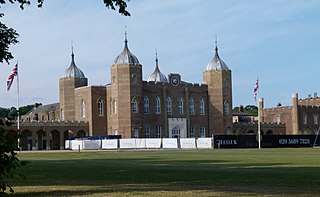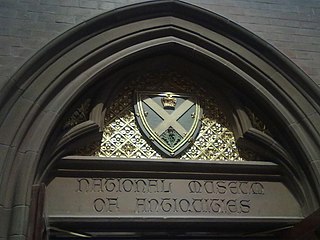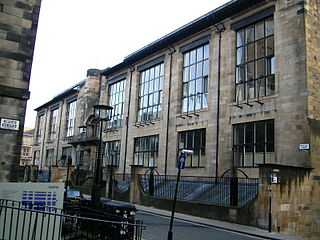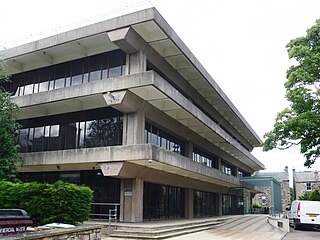Related Research Articles

The University of Glasgow is a public research university in Glasgow, Scotland. Founded by papal bull in 1451, it is the fourth-oldest university in the English-speaking world and one of Scotland's four ancient universities. Along with the universities of Edinburgh, Aberdeen, and St Andrews, the university was part of the Scottish Enlightenment during the 18th century.

Fife is a council area, historic county, registration county and lieutenancy area of Scotland. It is situated between the Firth of Tay and the Firth of Forth, with inland boundaries with Perth and Kinross and Clackmannanshire. By custom it is widely held to have been one of the major Pictish kingdoms, known as Fib, and is still commonly known as the Kingdom of Fife within Scotland. A person from Fife is known as a Fifer. In older documents the county was very occasionally known by the anglicisation Fifeshire.

Castle Douglas is a town in Dumfries and Galloway, Scotland. It lies in the lieutenancy area of Kirkcudbrightshire, in the eastern part of Galloway, between the towns of Dalbeattie and Gatehouse of Fleet. It is in the ecclesiastical parish of Kelton.

John Playfair FRSE, FRS was a Church of Scotland minister, remembered as a scientist and mathematician, and a professor of natural philosophy at the University of Edinburgh. He is best known for his book Illustrations of the Huttonian Theory of the Earth (1802), which summarised the work of James Hutton. It was through this book that Hutton's principle of uniformitarianism, later taken up by Charles Lyell, first reached a wide audience. Playfair's textbook Elements of Geometry made a brief expression of Euclid's parallel postulate known now as Playfair's axiom.

The University of St Andrews is a public university in St Andrews, Fife, Scotland. It is the oldest of the four ancient universities of Scotland and, following Oxford and Cambridge universities, the third-oldest university in the English-speaking world. St Andrews was founded in 1413 when the Avignon Antipope Benedict XIII issued a papal bull to a small founding group of Augustinian clergy. Along with the universities of Glasgow, Edinburgh, and Aberdeen, St Andrews was part of the Scottish Enlightenment during the 18th century.

St Andrews is a town on the east coast of Fife in Scotland, 10 miles southeast of Dundee and 30 miles northeast of Edinburgh. St Andrews had a recorded population of 16,800 as of 2011, making it Fife's fourth largest settlement and 45th most populous settlement in Scotland.

The Royal Military Academy (RMA) at Woolwich, in south-east London, was a British Army military academy for the training of commissioned officers of the Royal Artillery and Royal Engineers. It later also trained officers of the Royal Corps of Signals and other technical corps. RMA Woolwich was commonly known as "The Shop" because its first building was a converted workshop of the Woolwich Arsenal.

The Society of Antiquaries of Scotland is the senior antiquarian body of Scotland, with its headquarters in the National Museum of Scotland, Chambers Street, Edinburgh. The Society's aim is to promote the cultural heritage of Scotland.

The University of Dundee is a public research university in Dundee, Scotland. It is a red brick university, founded as a university college in 1881 with a donation from the prominent Baxter family of textile manufacturers. The institution was, for most of its early existence, a constituent college of the University of St Andrews alongside United College and St Mary's College located in the town of St Andrews itself. Following significant expansion, the University of Dundee gained independent university status by royal charter in 1967 while retaining much of its ancient heritage and governance structure.

The Glasgow School of Art (GSA) is a higher education art school offering undergraduate degrees; post-graduate awards and PhDs in architecture, fine art and design based in Glasgow, Scotland.

The McLellan Galleries are an exhibition space in the city of Glasgow, Scotland, situated behind a frontage of shops in Sauchiehall Street.

Aberdeen Grammar School is a state secondary school in Aberdeen, Scotland. It is one of thirteen secondary schools run by the Aberdeen City Council educational department.

Serge Ivan Chermayeff was a Russian-born British architect, industrial designer, writer, and co-founder of several architectural societies, including the American Society of Planners and Architects.

Julius Alfred Chatwin FRIBA, ARBS, FSAScot was a British architect. He was involved with the building and modification of many churches in Birmingham, and practised both Neo-Gothic and Neo-Classical styles. His designs always included all of the carvings and internal fittings.
Paul Waterhouse,, was a British architect.

The National Museum of Scotland in Edinburgh, Scotland, was formed in 2006 with the merger of the new Museum of Scotland, with collections relating to Scottish antiquities, culture and history, and the adjacent Royal Scottish Museum, with international collections covering science and technology, natural history, and world cultures. The two connected buildings stand beside each other on Chambers Street, by the intersection with the George IV Bridge, in central Edinburgh. The museum is part of National Museums Scotland. Admission is free.

St Salvator's Hall is a student Hall of residence at the University of St Andrews. It lies close to the quadrangle of the United College, St Andrews and St Salvator's Chapel, a foundation which was endowed by King James II of Scotland. The Hall is in an area between North Street and The Scores. Architecturally, it has been described as a "rambling Gothic dormitory".
Arthur Ashpitel (1807–1869) was an English architect. He trained under his father, William Hurst Ashpitel before setting up his own practice in 1842, and working in partnership with John Whichcord Jr. between 1850 and 1855. Ashpitel's works include the churches of St Barnabas, Homerton and St John the Evangelist, Blackheath.

James Brooks (1825–1901) was an English Gothic Revival architect.

The University of St Andrews Library dates back to the early 17th century but its books have been collected over some 600 years since the university was founded in 1413. It holds one of the most extensive collections of the research libraries in the United Kingdom with more than one million volumes. In addition to 210,000 printed books in special collections, it has large manuscript and photographic collections while its archives date back to the early 15th century. The library's current role is to support research, scholarship and learning with high-quality services backed by preservation, promotion and exploitation of its collections.
References
- ↑ "The Dictionary of Scottish Architects". Scottish Centre for Conservation Studies. 24 July 2012. Retrieved 1 October 2014.
- 1 2 "A Dictionary of Scottish Architects 1840–1980". School of Art History: Research: Featured Projects. University of St Andrews . Retrieved 24 May 2014.
- ↑ "Research Impact@St Andrews". University of St Andrews. February 2014. Retrieved 1 September 2014.
- ↑ "Welcome to the Dictionary of Scottish Architects". Dictionary of Scottish Architects. Retrieved 24 May 2014.
- ↑ McCrone, Elizabeth (1 August 2013). "'Listing is not about saving', says Historic Scotland's head of listing". Architects' Journal . Retrieved 14 December 2018.